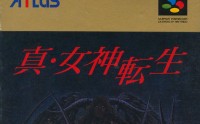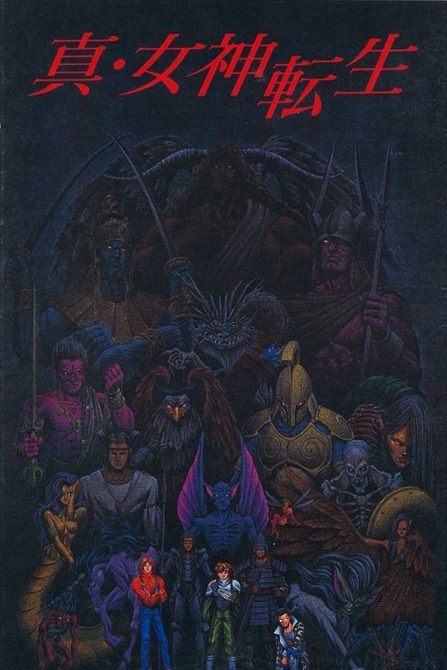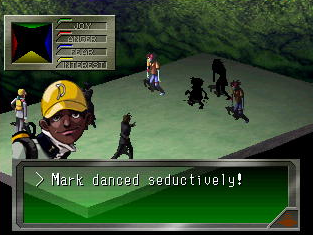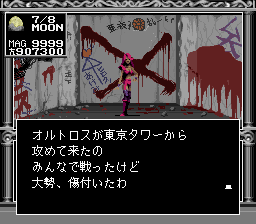By Jake Russell
The year is 1992. The place is Japan. With the Super Famicom and Genesis viciously battling for dominance of the video game market, various AAA titles were being released at a constant rate. The major RPG series that loomed over the rest of the market were Dragon Quest V and Final Fantasy IV for the SNES, and Phantasy Star III, Shining Force, and Lunar on the Genesis. The RPG market was in no short supply of what would be timeless classics. All of these games, whether on the SNES or the Genesis, each made it across the Pacific to the United States, which, at the time, was far from the most simple, efficient or cost-effective task. Naturally many excellent games got lost in the shuffle and couldn’t make it to the vast audience of gamers that America held. One of these excellent games was called Shin Megami Tensei. A JRPG that predicted the future.
What do we look for nowadays in a game? I’d say the answer is fairly obvious. Games like Final Fantasy XIII, a classic JRPG in most ways, are criticized for their oftentimes claustrophobic linearity. Many reviewers heavily criticized the tiny hallways that encompassed most of Final Fantasy XIII’s world. Final Fantasy XIII was one of the lowest scoring flagship games in the entire series and remains widely disappointing to most fans, whereas the games that won Game of the Year from many websites, blogs and publications were games like Mass Effect 2 and Red Dead Redemption, games that put a distinct focus on branching paths, different plots, the player’s control over the game’s story and world, and, most importantly, a non-linear style of gameplay, where one may approach different areas and different situations at different points in time. The most basic elements of many ‘classic’ JRPGs, such as the ones I’ve listed in the previous paragraph, are now thought of as gameplay pitfalls in the world of modern gaming. The elements we now treasure in the modern gaming world were very rare and barely present in games from the late eighties and early nineties, particularly in the genre of the Japanese Role-playing Game. Such a fact is ironic, seeing as how most role-playing games from Japan didn’t allow the player to fully play a role, or offer him truly impactful decisions. Until a little gem was released in the October of 1992. Shin Megami Tensei was its name, and it was about to introduce to the JRPG hallmarks of western RPG gaming that we treasure oh so dearly today.
The name ‘Shin Megami Tensei’ is probably a familiar one to you if you’re reading this rant. The Shin Megami Tensei series has a troubled history of localization. First brought to the states with a spin-off series, Revelations: Persona was released in 1997. The game, a perfectly decent offering in original Japanese, was absolutely butchered by its localization. Attempting to ‘americanize’ the game, the localization team made characters blonde and blue-eyed, and changed one character from a stylish Shinjuku kid into a thick ebonics-speaking African-American student. The translation was littered with typos, and gameplay was made easy and simple. The biggest change, however, was the removal of an alternative main quest, which, in the Japanese release, made up more than a third of the entire game. The game was a disaster, and following 2000’s Persona 2: Eternal Punishment the series’ next release stateside wasn’t until 2004, when Shin Megami Tensei: Nocturne was released. Nocturne is actually the third game in the flagship series, but was rebranded for its US release. Nocturne, by all accounts, was an excellent game, and was much adored by a relatively small, but devoted group of fans. These same fans supported the series with purchases of the other localized games, like Digital Devil Saga. The series finally had its breakthrough into the mainstream with the release of Persona 3. The game was a hit, and had to be reissued several times to satisfy intense demand. Chances are, this is how most of you know of the Shin Megami Tensei series. The series then went on to great critical and commercial reception with its later releases, such as Persona 4, a re-release of Revelations: Persona with minimal changes from the original version, and a DS game, Devil Survivor, which sold out so quickly, you will be hard pressed to find it at any game store in the states.
The true tragedy of Shin Megami Tensei’s story, however, is the neglect the first two flagship Shin Megami Tensei games have suffered in terms of stateside localization. Shin Megami Tenseis 1 and 2 are known as beloved classics in Japan, and deservedly so. Modern gaming conventions we treasure so dearly today are present in the SMT games, which were released in 1992. The games feature a deep, philosophical storyline that remains subtle while exploring elements of a huge scope, a non-linear story with many branching paths, a subtle morality system that doesn’t go too far to either extreme, a complex system of conversation to recruit demons into your party, a great deal of customization for characters’ stats and abilities and an epic plot set in 1990s Tokyo.
The games are first-person hallway-style dungeon crawlers, though with a lot of conversation and a lot of text. The games have many different branching paths, three different endings, and many choices to make. The games, while being set almost completely in aesthetically similar hallways, includes many branching plots, and an overworld map that remains relatively open once you’re about a quarter into the game. The game plays like a traditional turn-based RPG, but the player has the ability to recruit the monsters he encounters into his party through a conversation system, and is able to fuse them in various venues present throughout the game. The two games have plots involving the forces of Angels and Demons, and the battle between two major religions, as well as those that straddle the line between them. The two games are almost completely similar regarding gameplay, but the second game has a very different story from the first, though it deals with similar tones. The games are both available on the Super Famicom. They weren’t released in the states, though are obtainable with translations through various methods of dubious legality. The games are also often punishing in their difficulty.
Shin Megami Tenseis 1 and 2 do what no other JRPG had ever done, and they did it almost 10 years before another JRPG did it. The games are overlooked classics in the west, and the lack of love shown to them is truly tragic. The games are gems, and deserve to be tried by all lovers of modern RPG gaming. Unfortunately, unless you read Japanese, you can’t. However, if you really want to see what the Shin Megami Tensei series is all about, Shin Megami Tensei: Strange Journey on the DS is a throwback to the first two games in the series, and has almost all of their elements, only with a toned-down difficulty. The Shin Megami Tensei games, aside from their graphics, could have been from the future. The games’ use of modern gameplay conventions in a time when no one else was using them is incredible, and they deserve a look from every RPG fan who can play them. They stand among the greatest RPGs of all time, right alongside Final Fantasy, Baldur’s Gate, Planescape: Torment and Dragon Quest. Here’s to a localization at some point in the future. We can all dream, right?
Correction: Persona 2 actually came Stateside before Nocture.



